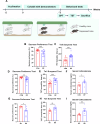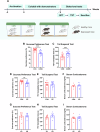Contagion of depression: a double-edged sword
- PMID: 39349463
- PMCID: PMC11443097
- DOI: 10.1038/s41398-024-03124-2
Contagion of depression: a double-edged sword
Abstract
Depression is a significant mental health issue with extensive economic implications, and recent studies suggest it may be transmitted between individuals. However, the mechanisms of this contagion remain unclear, and the social buffering effect has been understudied. This research employs three rodent models, including stress crossover, cohabitation-induced, and non-contact induced depression contagion models, to explore these mechanisms. Here, we report that that naive mice cohabiting with depressed mice showed increased corticosterone levels and depressive behaviors, unlike those with stressed mice, who did not exhibit these changes and even mitigated desperation in stressed mice. Non-contact cohabitation did not produce significant behavioral differences, but exposure to bedding from depressed mice reduced sucrose preference in naive mice. This study introduces reliable models of depression contagion, suggesting it operates independently of stress transmission. The interplay between depression contagion and social buffering may vary in different contexts. These findings provide new insights into the mechanisms of depression contagion and potential strategies for preventing depressive disorders.
© 2024. The Author(s).
Conflict of interest statement
The authors declare no competing interests. Drawing materials from BioRender are available with permission for publication.
Figures





References
-
- James SL, Abate D, Abate KH, Abay SM, Abbafati C, Abbasi N, et al. Global, regional, and national incidence, prevalence, and years lived with disability for 354 diseases and injuries for 195 countries and territories, 1990–2017: a systematic analysis for the Global Burden of Disease Study 2017. Lancet. 2018;392:1789–858. - PMC - PubMed
-
- Lu J, Xu X, Huang Y, Li T, Ma C, Xu G, et al. Prevalence of depressive disorders and treatment in China: a cross-sectional epidemiological study. Lancet Psychiatry. 2021;8:981–90. - PubMed
-
- Dubovsky SL, Ghosh BM, Serotte JC, Cranwell V. Psychotic depression: diagnosis, differential diagnosis, and treatment. Psychother Psychosom. 2021;90:160–77. - PubMed
MeSH terms
Substances
Grants and funding
LinkOut - more resources
Full Text Sources
Medical

